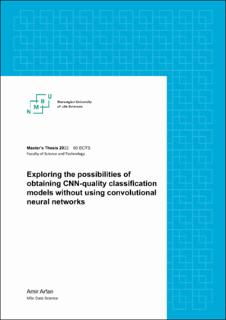| dc.description.abstract | In this thesis, we pursue the success of Convolutional Neural Networks for image classification tasks. We explore the possibilities of achieving state-of-the-art performance without explicitly using CNNs on 2D grayscale images.
We propose a Binary Patch Convolution (BPC) framework based on binarized patches from each group of images in a supervised task, eliminating the kernel learning process of CNNs. The binarized patches act as activations of different shapes and are applied using convolution. One of the key aspects of the framework is that it maintains a direct relation between the convolution kernels and the original images. Therefore, we can present a method to measure information content in a feature map for observing relations between different groups. We discuss and test different strategies for selecting groups of images to extract patches from while evaluating their effect on classification accuracy. The practical implementation of the BPC framework allows for many convolution kernels to be evaluated, positively impacting the framework’s performance. Ultimately, the proposed framework can extract pertinent features for classification and can be combined with any classifier. The framework is tested on the MNIST and Fashion-MNIST datasets and achieves competitive accuracy, even outperforming related work. We also discuss challenges and future work applicable to the framework.
Furthermore, we have attempted to capture trends in the error of images by proposing an iterative variant of singular value bases classification. The proposed method fails to capture a generalizable error trend; thus, we have recognized that it is a challenging task for images. The process has given valuable insight into how to approach image classification problems.
On top of that, we have examined the effects of negative transfer inherent in an original problem. Our experiments show that models trained on all groups in the data (global) are outperformed by models trained on different combinations of subgroups (local). Our proposed approaches for minimizing negative transfer within a task effectively increase classification accuracy. However, they are infeasible to deploy in practical scenarios due to the computation time introduced. The results are meant to motivate research toward within-task minimization of negative transfer, primarily since the existing research is focused on doing so in transfer learning. | |
